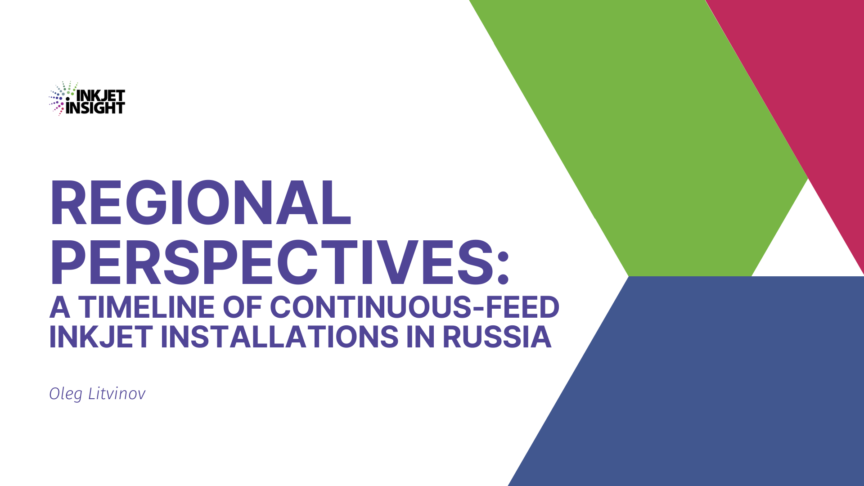By Oleg Litvinov
It has been over 10 years since the installation of the first high-speed continuous feed inkjet press in Russia. In 2010, one of the largest Russian transactional printing companies, Accord Post, installed the first Océ JetStream 1000 roll-fed press with 600×600 dpi resolution at speed of 75 meters per minute. The installation was carried out by Postyle company, official Océ distributor in Russia and Ukraine at that time. In 2012, a large book printing company, Chekhov Printing House, (JSC “First Model Printing House”) acquired an Océ JetStream 3300 with a printing speed of up to 150 m/min and a roll width up to 760 mm. It integrated the machine with the Muller Martini SigmaLine book blocks production line. The JetStream was developed under an OEM agreement with Miyakoshi and used Kyocera print heads with water-based ink (pigment or dye) for printing on uncoated paper. In the same year, Accord Post got a second inkjet press, this time an Océ ColorStream 3500 developed by Canon (Océ was acquired by Canon in 2010), and YAM International installed a Truepress Jet 520EX monochrome inkjet press at Federal State Unitary Enterprise Izvestia Publishing House with a Hunkeler finishing line for book production.
In 2014, a second roll-fed inkjet press machine was installed in Chekhov, also with Muller Martini inline finishing. This time Chekhov selected the Kodak Prosper Press 1000 with a print speed of up to 200 m/min.
One year later, in 2015, Xerox Russia completed installation of two Xerox Impika iPrint Compact presses. One of the machines was purchased by M-City (later the press was acquired by Accord Post), which used it to print State School Graduation exams. The second, in the 4+4 configuration, was installed for printing books at T8 Publishing Technologies. These machines have a print speed of 76 m/min at a standard resolution of 600×600 dots per inch and used a new high-contrast HD ink developed by the company. T8 Publishing expanded its fleet in 2017 with a second compact Xerox Impika iPrint device configured for two-sided monochrome printing on a wide (up to 511 mm) roll at a speed up to 127 m/min.
In 2018, Canon Russia installed the monochrome ColorStream 6500 with speed of 75 m/min and a resolution of up to 1200 dpi at the Pablit book printing house.
In 2019, the Smolensk Printing Plant (a branch of JSC “Higher School Publishing House”) acquired a Xerox Impika Evolution 250 TED 44 with unwinder and rewinder and Hunkeler Book Block finishing line.
In 2020, AO Forms Technology completed installation of three monochrome Xerox Impika Evolution towers for printing transactional documents, invoices and direct mail.
Finally, in 2021 contracts were signed for the two Canon ColorSream 6000 monochrome presses (4 towers in total) for a leading Russia postal company plus a new Canon ProStream 1000 (4+4) for the needs of one of the state ministries of Russian Federation.
Below is a table with the number of installed inkjet roll-fed presses in Russia (by units).
|
Vendor |
Number of presses |
Color |
Mono |
Transac-tional |
Book printing |
Other |
|
Océ/Canon |
7 |
3 |
4 |
4 |
2 |
1 |
|
Xerox Impika |
7 |
3 |
4 |
4 |
3 |
– |
|
Kodak |
1 |
– |
1 |
– |
1 |
– |
|
Screen |
1 |
– |
1 |
– |
1 |
– |
|
TOTAL: |
16 |
6 |
10 |
8 |
7 |
1 |
There is also information that last month T8 Publishing Technologies has chosen to install at least two Ricoh Pro™ VC20000 engines in addition to Impika machines to produce books on demand.
As shown in the table above, of the 16 machines installed in Russia, book and transactional printing occupy approximately equal shares. While the printing of invoices, statements and other documents is slowly but steadily declining, the volume of such work remains quite high. Large private and public companies working with the population may be interested in buying their own high-performance digital printing machines, a concrete example of which is the recent acquisition of two Canon machines by the leading Russian postal company.
The success of large and medium-sized print houses in digital book printing and changes in consumption patterns that have occurred among the population during the COVID-19 pandemic will contribute to the further development of digital book printing. Along with purely digital printers such as T8 and Pablit, larger publishers are interested in using offset, toner and inkjet printing together to meet clients’ run length, personalization, quality, and turnaround requirements. Printing houses in Chekhov and Smolensk demonstrate by their example the economic viability of this approach.
 Oleg Litvinov is a freelance business development consultant based in Brussels, Belgium.
Oleg Litvinov is a freelance business development consultant based in Brussels, Belgium.
He has been active in the printing industry for more than 20 years, specializing in Digital printing. Previously, with CREO, Oleg was responsible for the pre-sale analysis and support of Kodak distributors in Russia, Ukraine, Belarus, Baltic States and the former Soviet republics of Central Asia and subsequently negotiated Kodak’s largest contract in Russia. He has also held positions with Fuji Xerox and Canon supporting Russia and the APAC region. Leveraging this business experience along with an engineering background, Oleg has developed a strong track record for defining and implementing total printing solutions for customers.

